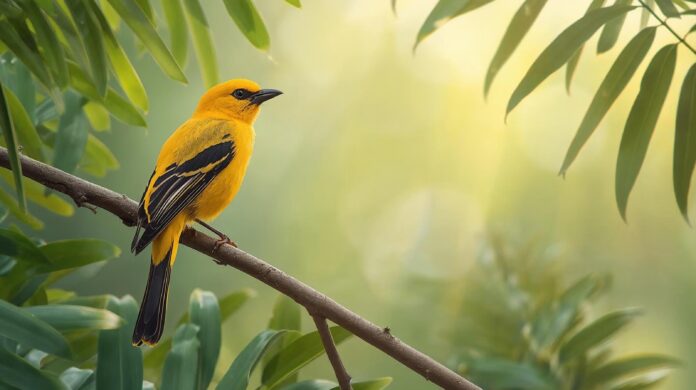The Golden Oriole is a bird of golden yellow colour. This bird is of two types — Indian variety and Eurasian species. The Golden Oriole of India was described by English naturalist William Henry Sykes in 1832 and given the zoological name Oriolus kundoo.
The Indian Golden Oriole is very similar to the Eurasian Golden Oriole except in some features — it has more yellow in its tail and a paler shade of red in its bill. The male has a black stripe extending behind the eye. The streaks on the underside of females are sharper than in the females of the Eurasian Golden Oriole. The Eurasian species is larger than the Indian species.
The Indian Oriole breeds in the areas of Baluchistan, Afghanistan, the Himalayas, and Nepal. The Indian Golden Oriole inhabits a range of habitats — deciduous forests, semi-evergreen forests, woodland, forest edge, mangroves, open country with trees, parks, gardens, orchards, and plantations.
The Golden Oriole breeds in Central Asia and the Indian subcontinent. The Indian Oriole is resident, but other species are migratory. The breeding season is from April to August. The nest is like a small cup placed in a fork near the end of a branch. It contains two or three eggs with reddish-brown and black speckling. Both parents take part in nesting and taking care of the young ones. They defend against enemies like crows. Orioles feed on fruits, nectar, and insects.
The breeding range of the Eurasian Golden Oriole is from Western Europe and Scandinavia east to China. They spend their winter in Central and Southern Africa. They migrate generally during the night but, in the spring season, during the day. The Eurasian Golden Oriole was spotted in 1758 by Carl Linnaeus — Curacies Oriolus.
The Eurasian and Indian varieties were treated as the same, but in 2005 they were treated as separate species. In the book Birds of South Asia, ornithologists Pamela Rasmussen and John Anderson made this differentiation. The name “oriole” was first used in the 18th century. The Latin word “aureolus,” meaning golden, is the root word.
The male is in black and yellow plumage, while the female is a drabber green bird. Orioles are shy. The male is difficult to see among the yellow and green leaves of the canopy. Its call is a harsh “kweeaahk,” but the song is weela-wee-ooo.
The Eurasian Golden Oriole inhabits a range of areas — in Western Europe, broadleaf forests; in Eastern Europe, coniferous forests. They avoid treeless habitats. In winter, they are found in tall forests, semi-arid and humid woodland, savannah, and riverine forests.
Eurasian Golden Orioles may delay breeding until they are 2 or 3 years of age. The nest is placed high in a tree toward the edge of the crown. The eggs hatch after 16–17 days. The young are fed by both parents. The greatest recorded age for a Eurasian Golden Oriole is 10 years and one month — ringed in Lincolnshire in 1986 and seen alive in Cambridgeshire in 1996.
All told, the Golden Oriole, be it Indian or Eurasian, is a beautiful bird. Truly, it is a golden bird. Moreover, this bird does not need conservation as it has a stable, large population — says BirdLife International.
(The views expressed are the writer’s own.)

Radhakanta Seth is a Former Income tax officer in Sambalpur. He is a Freelance writer and his articles have been published in some Oriya dailies like Sambad, Samaj, Dharitri and English dailies like The Telegraph and in a sociological journal ‘Folklore’ published from Kolkata.
(Photo has collected from net )

